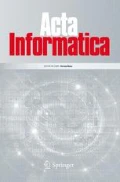Abstract
It is known that LTL formulae without the ‘next’ operator are invariant under the so-called stutter equivalence of words. In this paper we extend this principle to general LTL formulae with given nesting depths of both ‘next’ and ‘until’ operators. This allows us to prove the semantical strictness of three natural hierarchies of LTL formulae, which are parametrized either by the nesting depth of just one of the two operators, or by both of them. Further, we provide an effective characterization of languages definable by LTL formulae with a bounded nesting depth of the ‘next’ operator.
Similar content being viewed by others
References
Arnold, A.: A syntactical congruence for rational ω-languages. Theor. Comput. Sci. 39, 333–335 (1985)
Etessami, K.: A note on a question of Peled and Wilke on stutter-invariant LTL. Inform. Process. Lett. 75(6), 261–263 (2000)
Etessami, K., Wilke, Th.: An until hierarchy and other applications of an Ehrenfeucht-Fraïssé game for temporal logic. Inform. Comput. 160, 88–108 (2000)
Gabbay, D., Pnueli, A., Shelah, S., Stavi, J.: On the temporal analysis of fairness. In: Conference Record of the 7th ACM Symposium on Principles of Programming Languages, pp. 163–173. ACM Press (1980)
Kamp, J.A.W.: Tense Logic and the Theory of Linear Order. Ph.D. Thesis, University of California, Los Angeles (1968)
Kučera, A., Strejček, J.: The stuttering principle revisited: On the expressiveness of nested X and U operators in the logic LTL. In: Bradfield, J. (ed.) CSL’02: 11th Annual Conference of the European Association for Computer Science Logic, vol. 2471 of Lecture Notes in Computer Science, pp. 276–291. Springer-Verlag (2002)
Kučera, A., Strejček, J.: An effective characterization of properties definable by LTL formulae with a bounded nesting depth of the next-time operator. Technical Report FIMU-RS-2004-4, Faculty of Informatics, Masaryk University Brno (2004)
Lamport, L.: What good is temporal logic? In: Mason, R.E.A. (ed.) Proceedings of the IFIP Congress on Information Processing, pp. 657–667. Amsterdam, North-Holland (1983)
Peled, D., Wilke, Th.: Stutter-invariant temporal properties are expressible without the next-time operator. Inform. Process. Lett. 63(5), 243–246 (1997)
Peled, D., Wilke, Th., Wolper, P.: An algorithmic approach for checking closure properties of ω-regular languages. Theor. Comput. Sci. 195(2), 183–203 (1998)
Perrin, D.: Recent results on automata and infinite words. In: Chytil, M.P., Koubek, V. (ed.) Proceedings of the 11th Symposium on Mathematical Foundations of Computer Science, vol. 176 of Lecture Notes in Computer Science, pp. 134–148. Springer (1984)
Pnueli, A.: The temporal logic of programs. In: Proceedings of the 18th IEEE Symposium on the Foundations of Computer Science, pp. 46–57. IEEE Computer Society Press (1977)
Sistla, A., Clarke, E.: The complexity of propositional linear temporal logics. J. ACM 32, 733–749 (1985)
Thomas, W.: Star-free regular sets of ω-sequences. Information and Control 42(2), 148–156 (1979)
Thomas, W.: Automata on infinite objects. In: van Leeuwen, J. (ed.) Handbook of Theoretical Computer Science, vol. B, Formal Models and Semantics, pp. 133–191. Elsevier (1990)
Thue, A.: Über unendliche Zeichenreihen. Kra. Vidensk. Selsk. Skrifter, I. Mat. Nat. Kl. 1906(7), 1–22 (1906)
Wilke, Th.: Classifying discrete temporal properties. In: Meinel, C., Tison, S. (eds.) STACS’99: Annual Symposium on Theoretical Aspects of Computer Science, vol. 1563 of Lecture Notes in Computer Science, pp. 32–46. Springer-Verlag (1999)
Wolper, P.: Temporal logic can be more expressive. Inform. Control 56, 72–99 (1983)
Author information
Authors and Affiliations
Corresponding author
Additional information
This paper is a revised and extended version of [6].
Rights and permissions
About this article
Cite this article
Kučera, A., Strejček, J. The stuttering principle revisited. Acta Informatica 41, 415–434 (2005). https://doi.org/10.1007/s00236-005-0164-4
Received:
Revised:
Published:
Issue Date:
DOI: https://doi.org/10.1007/s00236-005-0164-4




